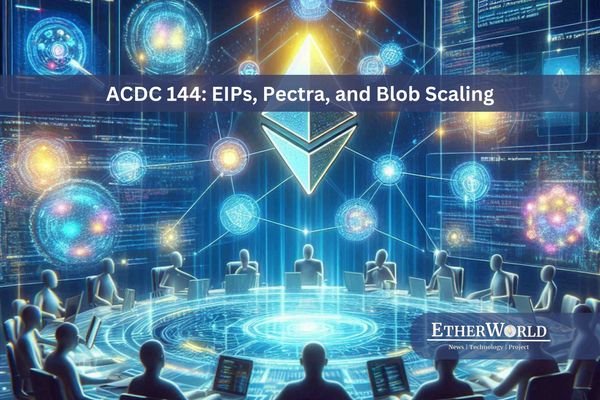The conversation in the latest Ethereum developers’ call revolved around Ethereum Improvement Proposals (EIPs) and their potential inclusion in the Electra upgrade. The discussion was prompted by the need to address ongoing challenges and improvements within the Ethereum network. Developers and stakeholders recognized the importance of refining various aspects, including security, consensus mechanisms, and efficiency in preparation for the upcoming Electra upgrade.
Potential issues to be addressed
Validator Deposit Handling:
Handling validator deposits presented concerns regarding the intricate nature of the process and its impact on software design. The complexity of managing these deposits within the Ethereum network led to discussions on streamlining the process to simplify software design and enhance the user experience. EIP 6110 addresses this concern by proposing to append validator deposits to Execution Layer (EL) blocks, thereby simplifying the handling of deposits and improving overall software design.
Consensus Mechanism Efficiency:
Efficiency concerns within the consensus mechanism, especially related to the aggregation of consensus votes, prompted discussions. The aim is to optimize the efficiency of the consensus mechanism by addressing specific challenges in the voting process. EIP 7549 comes into play by proposing a move of the committee index outside the attestation, providing a more efficient approach to consensus voting within the Ethereum network.
Trustless Staking Pool Designs:
The desire to enhance trustlessness in staking pools designs emerge as a key consideration. This involves addressing vulnerabilities associated with the relationship between active and withdrawal keys in staking mechanism. EIP 7002 focuses on enabling more trustless staking pools designs by replacing the dynamics between these keys contributing the improved security and trustlessness in staking operations.
Validator Set Size Growth:
Challenges associated with the growth of the validator set size raised consideration about maintaining a balance in the network. EIP 7251 proposes an increase in the maximum effective balance of validators as a measure to manage and control the growth of the validator set size. This adjustment aims to prevent unbounded growth over time providing a sustainable approach to the evolving dynamics of the Ethereum network.
Data Availability Scaling:
The need for scaling data availability as outlined in EIP 4844, prompted discussions on potential enhancements EIP 7594 known as Peer Data Availability Sampling (PeerDAS), emerges as a proposal to extend data availability scaling beyond the initial specifications this extension in crucial in addressing the growing demand for efficient data handling, particularly in the context of Layer 2 protocols, ensuring the scalability of the Ethereum network.
Proposed Solutions
Append Validator Deposits to EL Blocks
EIP 6110 proposes appending validator deposits to Execution Layer (EL) blocks, aiming to simplify software design and enhance user experience. This change streamlines the handling of validator deposits, reducing software complexity and improving the overall interaction for users within the Ethereum network.
Move Committee Index Outside Attestation
EIP 7549 focuses on optimizing consensus voting efficiency by relocating the committee index outside the attestation process. This adjustment aims to enhance the performance of the consensus mechanism in Ethereum by separating the committee index from the attestation process.
Enable Trustless Staking Pool Designs
EIP 7002 addresses issues related to validator keys, enabling more trustless designs for staking pools. The proposal aims to refine the relationship between active and withdrawal keys in staking mechanisms, contributing to the security and trustlessness of staking pool designs.
Increase Maximum Effective Balance of Validators
EIP 7251 proposes increasing the maximum effective balance of validators from 32 ETH to 2048 ETH. The objective is to manage the growth of the validator set size by adjusting the maximum effective balance, preventing unbounded growth over time within the Ethereum network.
Mechanism for Validators to Include Specific Transactions
EIP 7547 introduces a mechanism for validators to forcibly include specific transactions in a block, enhancing censorship resistance. This proposal addresses concerns related to transaction censorship on the Ethereum network by empowering validators to include specific transactions in blocks.
Extend Data Availability Scaling Beyond EIP 4844
EIP 7594 extends data availability scaling beyond the specifications of EIP 4844. By allowing nodes to sample blob data, this proposal contributes to scalability benefits, particularly important with the growing demand from Layer 2 protocols within the Ethereum ecosystem.
Update Serialization Scheme for Efficiency and Accuracy
The SSZ-related EIPs, including EIP-6404, EIP-6465, EIP-6466, and EIP-7495, collectively aim to update Ethereum's serialization scheme. These proposals focus on reducing transaction inclusion proof size, enhancing accuracy in data fields used in EL block headers, and bringing overall efficiency gains to Ethereum's serialization process.
Why There Might Be Some Urgency Around Including a Simple First Step of That Roadmap in Electra Already?
The implementation of immediate measures is imperative in addressing critical challenges faced by the Ethereum network.immediate execution is crucial not only for enhancing security, as exemplified by the significant security improvement introduced by EIP 6110, but also for streamlining consensus mechanisms and addressing efficiency concerns. The urgency stems from the need to promptly fortify the network's robustness.
Integrating a simple first step in Electra, such as the proposed security enhancement in EIP 6110, provides immediate benefits to the network's security posture. The focus on efficiency improvements across both consensus and execution layers underscores the commitment to an optimally performing Ethereum network.
However, this urgency is carefully balanced with the imperative to maintain a narrow scope for the Electra upgrade. This approach ensures pragmatic and achievable enhancements within the desired timeframe, promoting a judicious equilibrium between urgency and feasibility in evolving the Ethereum ecosystem.
Read More
-
scroll-successfully-launches-mainnet-for-zkevm-boosting-ethereum-scalability
-
Solutions to Scalability: Can Off-Chain Payments Scale Blockchain?
Disclaimer: The information contained in this website is for general informational purposes only. The content provided on this website, including articles, blog posts, opinions, and analysis related to blockchain technology and cryptocurrencies, is not intended as financial or investment advice. The website and its content should not be relied upon for making financial decisions. Read full disclaimer and privacy Policy.
For Press Releases, project updates and guest posts publishing with us, email to contact@etherworld.co.
Subscribe to EtherWorld YouTube channel for ELI5 content.
Share if you like the content. Donate at avarch.eth or Gitcoin
You've something to share with the blockchain community, join us on Discord!







